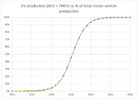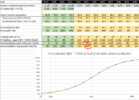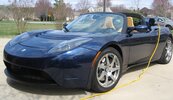The best predictor of future performance is past performance.
Enough 2022 data has become available to do some meaningful crunching. I've not completely finished that yet, and there are some minor inconsistencies that I either haven't scrubbed out or don't yet have good data to scrub out. (
So please don't fuss about any minor data inconsistencies). The data sources are the same public domain ones as I have used in the past, for previous annual summaries that I have put out at this point in the year. Already there is some interesting stuff emerging.
Crucially this raises two interesting questions on the cell supply front, which I would appreciate the views of those who have dug further into that:
- Q1. Can the cell suppliers (and their mineral suppliers) continue to meet the total annual increases that the historical evidence suggests will continue to be met ?
- Q2. Can Tesla continue to capture at least a 20% market share of that cell supply for vehicle use ?
Let us be clear, Tesla is doing very well in growing the business. But also, and we must recognise this, so too are the aggregate of all the other auto makers and their corresponding supply chain partners.
In my analysis I only classify 'pluggable' electric vehicles as EVs, i.e. EV = BEV + PHEV. The fuel cell vehicles (FCEV) and the non-pluggable hybrids I just lump in with internal combustion (ICE) as they are rounding errors. First of all we can see that the overall vehicle market has substantially stabilised but not necessarily recovered. Dino-juice (ICE) vehicle production is now falling and there is a growing wedge of EV production making up the market. The pluggable hybrid segment (PHEV) is still growing but its growth is definitely decellerating and it is clearly going to be a dead-end for the mass-market PHEV fairly soon.
View attachment 908943
Looking more closely at the EV market here is the overall market situation at the end of 2022 with the corresponding market shares in tabular form. It is important both to understand the vehicle shares, and the cell supply shares. You can see in the battery/vehicle that all vehicles are trending towards a greater cell capacity, no surprise there. At this rate of cell/vehicle growth in another three years non-Tesla BEV will be at 60kWh vehicle pack sizes:
View attachment 908924
Or if you prefer graphical form this is the market share situation :
View attachment 908926
Tesla's share of the EV market peaked in 2019 at 17% by vehicle volume, and also in 2019 Tesla's share of EV battery supply peaked at approx 35-32%, and on both metrics Tesla's share has been sliding since, now (2022) being at 12% and 22% respectively. So one needs to recognise that Tesla has done an outstanding job of growing
profitably, but also to recognise that in aggregate the other auto makers (and their supply chain partners) have grown their EV offerings
even faster than Tesla since then, albeit the likelihood is that they have struggled do do so profitably in EVs.
This is relevant because the long-run dataset is now providing a good match for S-curve adoption models in a way that there was not sufficient data to meaningfully predict before. And the result is dramatic,
with it being game-over by 2030 if the current adoption trajectory is sustained.
View attachment 908942
This S-curve (grey) is a three parameter logistics curve that has been history-matched against actual data (green) from 2010-2022 using a computerised 'solver' to get the least-error fit.

en.wikipedia.org
Previously it did not seem to me that there was sufficient data to get a reliable result, plus there was the added confusion of the Covid pandemic. But now that there is stabilisation observable - and significantly - the Covid pandemic has not been too disruptive for EV growth, then a sufficient match seems to be emerging. And it is going faster than was expected as the incumbent ICE manufacturers are trying; and as the new-entrant ICE and EV players are very competitively forcing the transition (the switch of BYD to a full-EV manufacturer is very important).
As a generalisation such a growth model is a good prediction tool provided that a new constraint does not impose itself on the scene, and the constraint that I think we need to be aware of is in relation to cell supply growth, and everything necessary to achieve that in terms of raw materials etc. So let us look more closely at that. I've circled two cells in red for 2024, but first observe that the overall growth rate is tending to trend down. The 345 GWh vehicular ccell capacity production adds for 2023 appear realistic given the achieved 208GWh production add for 2022, and note that there must be excess production add available - we know this because the stationary storage market is also growing.
(This tends to suggest that whilst Covid has had a discerbable effect of EV adoption, it has not been the cause of a 'catch-up' of excess capacity in 2022. My suspicion is that all manufacturers prioritised keeping EV lines going during Covid, and preferentially idled ICE lines whenever supply chain disruptions became unamanageable. That there was some impact from Covid is also discernable when one looks at the actual vs history match error term, but it is surprising how small it is. Overall I don't think the history match is being fooled by Covid artefacts.)
But the crunch year is 2024 where 756GWh of additional vehicle cell capacity is needed. If the 2024 growth rate of 92% can be managed then everything after that is easy. And the reason why it is so large is that this forecast now assumes a strong return to the previous size of vehicle market that had been over 90-million per year, specifically to 92m/yr in 2024, and so this flows down to the cell demand. And because in the past the cell manufacturers did meet the demand, then the question becomes will they do so again ? Especially noting that excess cell capacity, primarily LFP, is flowing into the stationary market. After all the best predictor of future performance is past performance.
View attachment 908944
The alternatives are:
- vehicle buyers will switch from BEV to ICE at the margin, and the 92m demand will persist but be met by dino-juice; or
- vehicle buyers wil postpone vehicle purchases until BEVs become available, and the market will become capped at approx 80m/yr for several years; or
- the average cell/vehicle trend will flatten through the supply crunch, with a mixture of small-pack BEV and small-pack PHEV competing against big-pack Teslas so keeping the >90m/yr vehicle count but failing on the cell-supply (bad news for wannabe US-pick-up-truck drivers migrating from ICE to BEV); or
- cell suppliers (and their mineral supply chains) will meet the challenge.
For the time being I tend to discard the option that vehicle productivity/utilisation metrics will increase, i.e. I am being pessimistic regarding the likelihood that autonomous vehicle technology will be significant in this time period. Opinions may differ on this.
Hence my posing the first question :
- Q1. Can the cell suppliers (and their mineral suppliers) continue to meet the total annual increases that the historical evidence suggests will continue to be met ?
Turning to the effect for Tesla the quick take is that if this S-curve does play out, then the
maximum (best) outcome for Tesla is to achieve its own stated target of 20 million vehicles per year by 2030. There is unlikely to be significant market growth of EVs after 2030, perhaps even decrease if autonomous driving eventuates. So for Tesla to grow after 2030 would require Tesla to gain market share from other EV manufacturers at that point, which is a zero-sum game. However we then need to return to this table and note that on EV vehicles Tesla is down to 12% market share, therefore Tesla will have to recapture EV market share in order to obtain a approx 19-20% market share by 2030 that is implicit in the stated target of 20m/yr. To pre-emptively counter the valid response that the BEV market share is what matters, one really needs to look at the core underlying constraint which is the cell supply. Here the Tesla cell position is 22% at end of 2022, so still on track.
View attachment 908924
But equally one can see that the Tesla cell position has been declining from its peak, and has been declining at a rate of 2-4% per year. This is because the other manufacturers have been outperforming Tesla in sourcing cells (even if they have made some bad decisions, such as going for pouch). Nevertheless as a minimum Tesla will need to arrest that decline in the cell supply fraction and hold it above 20% for a decade if it is to achieve its 20m vehicles/year target. The reason why Tesla has to capture a >20% cell supply fraction in order to meet its vehicle ramp targets is because Tesla puts larger packs in its vehicles, so Tesla has to try harder.
At the level of a Tesla shareholder this does tend to focus the share price analysis down to 'only' the 2030 time horizon. And if one is as cautious as I am regarding the financial performance of the Tesla energy side of the business (and I'm no bear)*, then the vehicle side's performance over the next 7-years is critical. If the decay in Tesla's relative position continues then if the vehicle parameter
stabilises at 12% of EV, then the Tesla vehicle quantity will be 'only' 10.5 million/yr in 2030, and even this would represent a turnaround in the rate and direction of the ongoing decline in the cell % share. Staying above a 20% cell fraction is crucial for Tesla shareholders !
Hence my posing the second question :
- Q2. Can Tesla continue to capture at least a 20% market share of that cell supply for vehicle use ?
These are absolutely dramatic rates of change we are witnessing, utterly transformative in a global sense for all humanity. At this point of course minor changes in trends might *sugar* things by a few years, or by a few tens of millions, but nonetheless the sheer scale and speed of what is going on is amazing. I've been working towards this for 30-years of my professional career in the wider energy sector, so it is very gratifying to see it coming to fruition. I am also a Tesla shareholder.
It is in that context that I pose the two questions I do.
* As an aside, by looking at the vehicle cell production add, one can see that global stationary storage uptake will really accelerate after 2025/2026. Until then the vehicle market will be the dominant cell growth driver.







